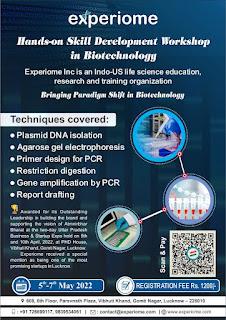Biotech Research Centre in Lucknow | Biotech Training in Lucknow | Experiome Inc
Next Generation Sequencing (NGS)
Next generation sequencing also known as high-throughput sequencing as it can sequence many DNA strands at the same time. This technology is used to study genetic variations associated with diseases by determining the sequence of DNA or RNA. Methods of Next generation sequencing are as follows:
1.Massively Parallel Signature Sequencing
This technology uses type II restriction endonuclease, a mixture of adapters with all possible overhangs which is annealed to the target sequence, leading in a single adapter with a perfect complimentary overhang being ligated. Since every adapter has its own label, the overhangs are recognised immediately after ligation. The number of oligonucleotide tags is 100 times greater than the number of template samples, ensuring that each template sample is conjugated to a unique tag. Signatures are generated by monitoring successful adapter ligations onto a surface of microbeads in a flow cell. This procedure uses millions of microbeads, and because each bead is connected to a single copy of the template, the sequencing reaction yields millions of signature sequences. Following that, cleavage using a type II restriction endonuclease exposes additional bases for identification in successive cycles. The fluorescent signals from the array of microbeads are recorded on a CCD camera, resulting in a digital representation of each microbead. Image-processing software then follows the positions of fluorescent signals from individual microbeads in the flow cell.
In it a universal linker or mate pair tags
are used to circularise size-selected genomic segments. After that, universal
sequences with complementary sections for sequencing or amplification primers
are added to each fragment. Following emulsion PCR enrichment and immobilisation
onto flow cells for monolayering, automated sequencing is conducted. During
each sequencing cycle, four-color imaging is used to determine the sequence of
each amplified bead at a specific location across several hundred raster
points.
Adapters are used to link fragmented template DNA to microbeads, followed by denaturation and a high dilution of the resulting library. Dilution is done to the point that each bead contains no more than a single DNA fragment. Individual DNA fragments are amplified using emulsion PCR after the DNA beads have been diluted. Emulsion PCR involves mixing beads containing DNA fragments, adapters, and PCR reagents with emulsion oil to create water droplets in an oil emulsion, resulting in droplets of water containing a single bead with a single DNA fragment attached. The PCR subsequently amplifies the DNA inside the water droplets in the oil solution, resulting in 106 double-stranded copies of the library segment in each bead. The amplified DNA-beads are then loaded into picotiter plates in such a way that each well contains only one bead and sequencing enzymes. Individual wells are packed with packing beads to assure the presence of a single bead in each well. The addition of one dNTP in each PCR cycle is then used to perform pyrrosequencing in a sequencing machine. When a proper nucleotide is incorporated, luciferase produces an oxyluciferin signal, which leads to the recognition of the individual nucleotides added to the nascent DNA. The sequence of the template fragment in each well is determined by the signals of each dNTP integrated, and the data of the resulting signals is pooled to give a sequence readout of all fragments.
Ion torrent chip has compartments and
micro arrayed wells with solid state pH sensors. In it via emulsion PCR,
sequence templates are generated on the beads resulting in oil-water emulsion
spheres. An emulsion PCR results in the amplification of individual fragments
to millions of identical copies that are linked to the beads, permits final
detection of the signal. Each sphere includes one library molecule plus
chemicals for the amplification. If an applied base is at that place in the
template, a change in pH is noticed because individual dNTPs are applied in several
cycles in a sequential order. When an identical stretch of bases is present,
the pH changes by a factor of two, which is recognised and interpreted.
5.Sequencing by Oligonucleotide LigationDetection
It consists of fragmented DNA samples, end repair, and ligation of two different DNA adapters to the ends of the library fragments. The capacity of DNA ligase to recognise and integrate bases in a very particular manner is the basis of this sequencing. DNA fragments connected to beads are clonally amplified by emulsion PCR in sequencing by ligation. Following PCR, specific primers hybridise to the adaptor sequence of the amplified templates on the beads, resulting in a free 5′ phosphate group for ligation to the fluorescently labelled probes (known as interrogation probes) rather than a 3′ hydroxyl group as in traditional polymerase-mediated extension. The interrogation probe is 8 bp long, with the first two bases being specific and the next six bases being degenerate. At the end, a set of four fluorescently labelled interrogation probes compete for ligation to the sequencing primer, each of which has one of 16 potential 2-base combinations. When a probe is ligated, fluorescence is collected that corresponds to the probe ligated. The connected probe's "fluor" is eliminated in the second cycle, and a 5′ phosphate group is regenerated. Multiple ligation, detection, and cleavage cycles are carried out, with the number of cycles defining the final read length. The extension product is removed after a set of ligation cycles (typically seven), and the template is reset with a primer complementary to the n-1 location for another set of ligation cycles. Each time, a new primer with a different offset is used to continue the procedure.

Comments
Post a Comment